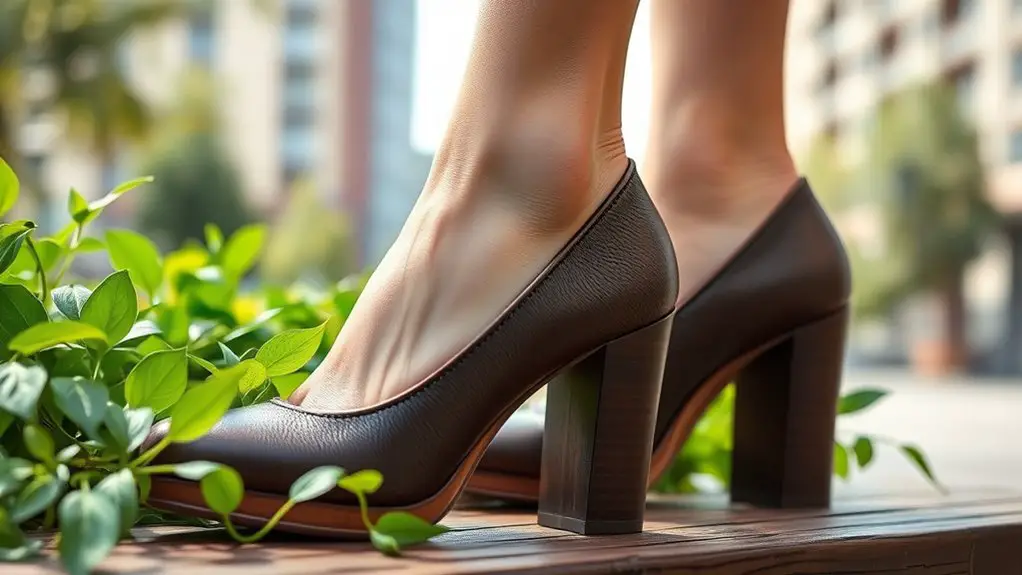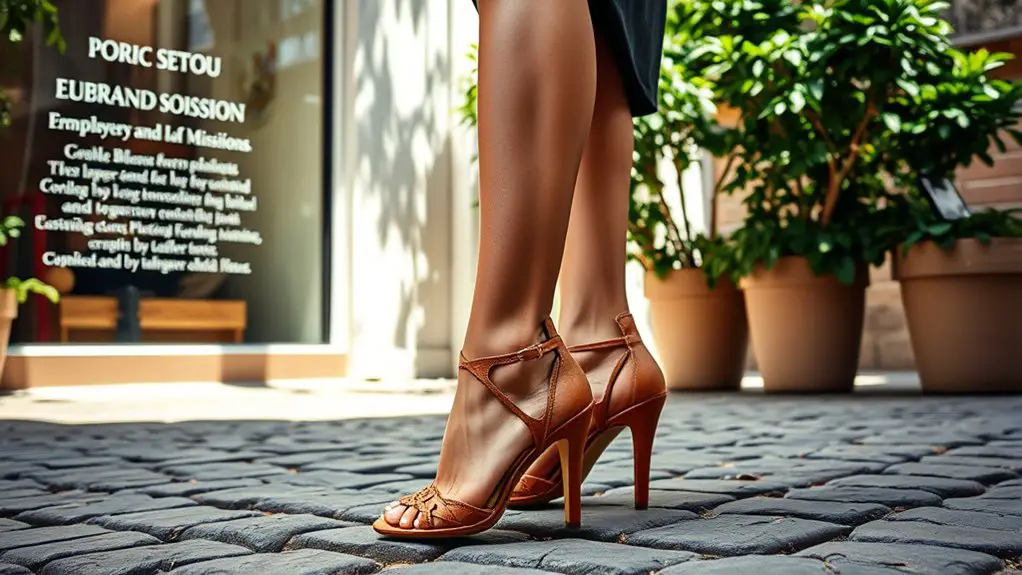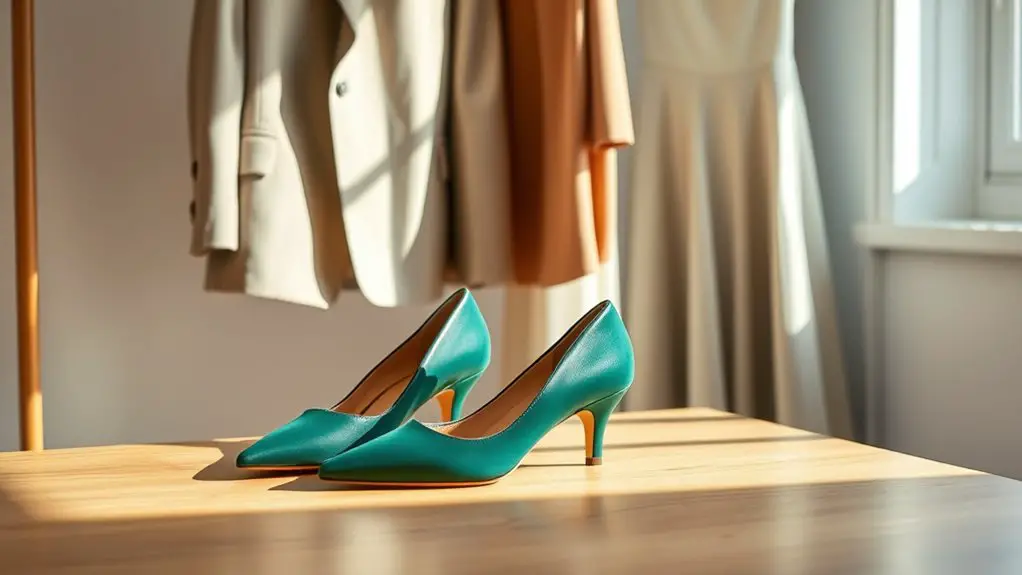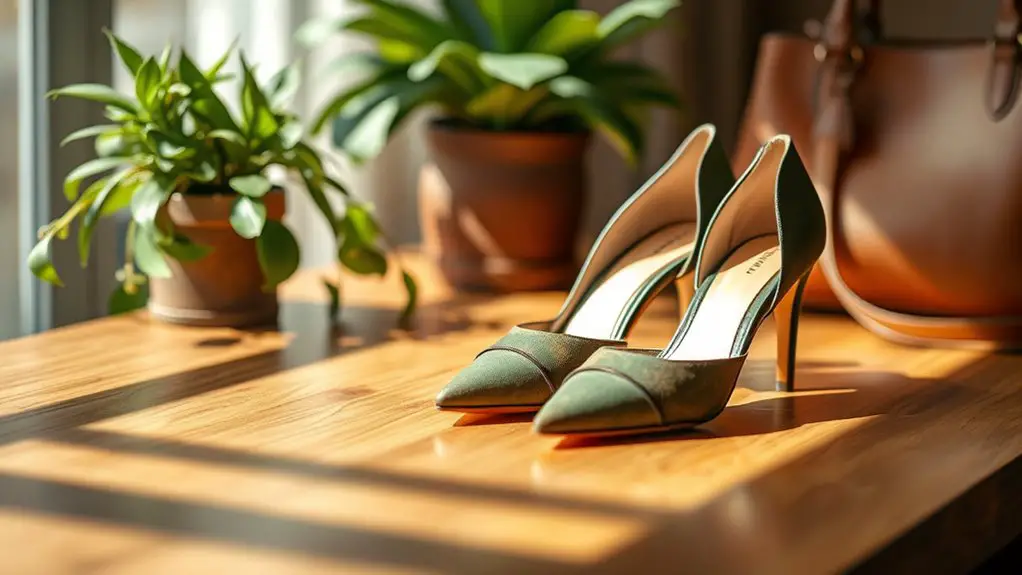Choosing sustainable heels without sacrificing style means looking for eco-friendly materials like recycled fabrics or sustainable leather, and checking for ethical production practices. Prioritize brands that offer transparency in sourcing and have credible certifications. Focus on comfort with features like cushioned insoles and adjustable straps, while opting for timeless designs that pair well with various outfits. Don’t forget to explore local artisans for unique finds, and there’s much more to explore about sustainable choices ahead.
Understanding Sustainable Materials in Footwear

When you’re on the hunt for sustainable heels, it’s essential to understand the materials that make them eco-friendly. One of the best options is sustainable leather, which comes from tanneries that prioritize environmental practices. This type of leather often uses less water and fewer harmful chemicals in its production, making it a better choice for the planet.
Another fantastic option is footwear made from recycled materials. Brands are increasingly turning to recycled plastics and textiles, transforming waste into stylish, durable heels. This not only reduces landfill waste but also minimizes the use of new resources.
When you choose heels made from these materials, you’re not just making a fashion statement; you’re also supporting a more sustainable future. So, next time you shop, look for labels that highlight sustainable leather and recycled materials—your feet and the planet will thank you!
Researching Ethical Production Practices
Understanding the materials in sustainable heels is just the beginning; the next step is to look into the ethical production practices behind them. You’ll want to guarantee that your stylish choices align with your values. Here are three key areas to focus on:
- Ethical Sourcing: Check if the materials are sourced responsibly, guaranteeing that workers are treated fairly and that natural resources are protected.
- Production Standards: Look for brands that adhere to high production standards, which often include fair wages, safe working conditions, and environmentally friendly practices.
- Certification: Seek out certifications from reputable organizations that verify a brand’s commitment to ethical practices, adding an extra layer of assurance.
Evaluating Brand Transparency and Accountability

How can you be sure a brand truly stands behind its claims of sustainability? Evaluating brand transparency and accountability is key. Look for brands that openly share their practices, values, and sourcing methods. This not only builds consumer trust but also shows their commitment to ethical standards.
| Transparency Indicators | What to Look For |
|---|---|
| Brand Values | Clear mission statements |
| Production Details | Information on sourcing |
| Environmental Impact | Reports on sustainability |
| Labor Practices | Fair wages and working conditions |
| Certifications | Third-party validations |
When a brand is transparent, it’s easier to align with your values. So, take the time to research and ask questions. The more you know, the better choices you can make for your wardrobe and the planet. Remember, sustainable heels can be stylish and responsible!
Exploring Eco-Friendly Certifications
When you’re shopping for sustainable heels, knowing the eco-friendly labels can make all the difference. Look for certifications like FSC, GOTS, or Fair Trade, which indicate responsible sourcing and production practices. Understanding these certifications not only helps you make informed choices but also supports brands committed to sustainability.
Understanding Eco-Friendly Labels
What makes a shoe truly eco-friendly? Understanding eco labels is essential in your quest for sustainable heels. These labels signify a commitment to ethical fashion and environmentally responsible practices. To help you navigate this landscape, here are three key points to take into account:
- Material Sourcing: Look for shoes made from organic, recycled, or sustainable materials. This reduces the environmental impact.
- Production Practices: Brands should prioritize fair labor practices and minimize waste during manufacturing.
- Certifications: Recognize reputable eco labels that validate a brand’s commitment to sustainability.
Certifications to Look For
While steering through the world of sustainable fashion, it’s crucial to recognize the certifications that truly reflect a brand’s commitment to eco-friendly practices. Look for labels like Global Organic Textile Standard (GOTS) or Fair Trade, which guarantee sustainable materials and ethical labor practices. The Forest Stewardship Council (FSC) certification guarantees responsible sourcing of wood-based products, while the Leather Working Group (LWG) focuses on environmentally responsible leather production. These ethical certifications not only indicate a brand’s dedication to sustainability but also assure you that your stylish heels are crafted with care for both the planet and its people. By choosing footwear with these certifications, you’re making a conscious choice that aligns with your values without sacrificing style.
Impact of Certifications
Choosing footwear with recognized certifications can substantially influence the overall impact of your fashion choices. Certifications help guarantee that the materials and processes used align with eco-friendly standards. Understanding certification importance can guide you in making informed decisions. Here are three key benefits of choosing certified sustainable heels:
- Transparency: Certifications provide an impact assessment of the production process, revealing the environmental and social practices behind the brand.
- Quality assurance: Certified products often meet higher quality standards, guaranteeing durability and longevity in your wardrobe.
- Ethical practices: Many certifications emphasize fair labor practices, giving you peace of mind that your purchase supports ethical treatment.
Prioritizing Comfort and Fit in Sustainable Heels
When it comes to sustainable heels, balancing comfort and fit is essential for both your well-being and the planet. You want to look great, but if your heels aren’t comfortable, you won’t wear them often. Prioritize comfort features like cushioned insoles and arch support, which can make a big difference during long wear.
Here’s a quick guide to help you evaluate comfort and fit:
| Comfort Features | Fit Adjustments |
|---|---|
| Cushioned insoles | Adjustable straps |
| Arch support | Wide or narrow sizing |
| Breathable materials | Ankle support |
| Shock-absorbing heels | Customizable footbeds |
Considering Versatility for a Capsule Wardrobe

When building a capsule wardrobe, choosing heels with timeless design elements can make all the difference. By focusing on color coordination and selecting styles that easily shift from day to night, you’ll maximize your outfit options. Let’s explore how to make versatile choices that enhance your sustainable wardrobe.
Timeless Design Elements
There’s something undeniably appealing about timeless design elements in footwear, especially when you’re curating a capsule wardrobe. Focusing on classic silhouettes and elegant embellishments can elevate your style while ensuring versatility. Here are three key design elements to evaluate:
- Classic Silhouettes: Opt for heels like pointed-toe pumps or block heels that never go out of style and pair well with various outfits.
- Elegant Embellishments: Look for subtle details like a delicate strap or a refined bow that adds a touch of sophistication without overwhelming the design.
- Neutral Tones: Choose colors that easily complement your existing wardrobe, making it effortless to mix and match.
Color Coordination Tips
To maximize the versatility of your capsule wardrobe, mastering color coordination is essential, especially with heels that can elevate any outfit. Start by using the color wheel to identify complementary colors. For instance, pairing a pair of nude heels with bold hues helps maintain outfit balance, allowing your shoes to enhance rather than overpower. Earthy tones like olive or rust are also great choices for versatile heels that work with various palettes. Consider neutral shades, as they seamlessly blend with multiple outfits, ensuring you get the most wear out of your sustainable choices. Ultimately, the right color coordination not only highlights your style but reinforces the sustainability of your wardrobe, making each pair of heels a smart investment.
Day-to-Night Transition
Mastering color coordination not only enhances your style but also sets the stage for effortlessly shifting from day to night with your heels. To achieve day-to-night versatility, consider these tips for adapting seamlessly:
- Choose Neutral Tones: Opt for heels in shades like beige, black, or navy that pair well with various outfits.
- Add Statement Accessories: Elevate your daytime look with bold jewelry or a chic clutch for evening elegance.
- Select Comfortable Styles: Look for sustainable heels with cushioned insoles or block heels, ensuring comfort for long hours.
Embracing Timeless Styles Over Fast Fashion
How often do you find yourself drawn to trendy heels that quickly fade from style? Instead of chasing fleeting fashion, consider investing in classic silhouettes that exude enduring elegance. Timeless designs, like pointed-toe pumps or chic ankle boots, will complement a variety of outfits and occasions, ensuring you’ll look polished season after season.
By prioritizing these styles, you not only elevate your wardrobe but also contribute to sustainable practices. Fast fashion contributes to environmental waste, while classic heels last longer and retain their charm. When you choose quality over quantity, you’re making a conscious decision that benefits both you and the planet.
Look for materials that promise durability, and opt for neutral colors that can seamlessly blend with your existing wardrobe. Embracing timeless styles means you’ll feel confident and stylish, all while making a positive impact. Choose wisely, and your feet—and the Earth—will thank you!
Finding Local Artisans and Sustainable Brands
When searching for sustainable heels, consider looking for local artisans who craft unique pieces with care. Exploring eco-friendly brands can also lead you to stylish options that prioritize sustainability. Don’t forget to visit artisan markets, where you can connect directly with creators and discover one-of-a-kind footwear.
Research Local Artisans
While you might think big brands dominate the footwear market, exploring local artisans can lead you to unique, sustainable heel options that align with your values. By choosing artisan craftsmanship, you not only support local economies but also embrace quality and creativity. Here’s how to find the perfect local designs:
- Visit Craft Fairs: Local craft fairs often showcase talented artisans who specialize in sustainable footwear, allowing you to connect directly with the makers.
- Use Social Media: Platforms like Instagram can help you discover local designers sharing their creations, making it easy to explore their work and philosophy.
- Search Online Marketplaces: Websites dedicated to handmade goods often feature local artisans, providing a curated selection of ethically produced heels.
Dive into the world of local craftsmanship for sustainable style!
Explore Eco-Friendly Brands
If you’re enthusiastic to find sustainable heels that reflect your values, exploring eco-friendly brands can be a game-changer. Look for eco-conscious designers who prioritize ethical production and sustainable materials. Many brands focus on creating stylish footwear while minimizing their environmental impact, ensuring you don’t have to sacrifice style for sustainability. Check out companies that use recycled materials, natural dyes, or even upcycled components in their designs. You’ll often find that these sustainable fashion brands not only offer unique aesthetics but also support fair labor practices. By choosing eco-friendly heels, you’re contributing to a more responsible fashion industry and promoting artisans who care about the planet. So, immerse yourself in your search and discover the perfect pair that aligns with your values!
Visit Artisan Markets
Exploring artisan markets can be a rewarding way to discover local artisans and sustainable brands that prioritize craftsmanship and eco-friendly practices. When you visit these markets, you’ll find unique heels that reflect artisan craftsmanship and a commitment to local sourcing. Here are a few tips to enhance your experience:
- Engage with Artisans: Talk to the creators about their materials and methods, deepening your understanding of their sustainable practices.
- Look for Certifications: Seek brands that are transparent about their eco-friendly credentials and sourcing efforts.
- Support Local Economies: By purchasing directly from artisans, you contribute to your community and help promote sustainable practices.
Caring for Your Heels to Extend Their Lifespan
Caring for your heels is essential if you want to keep them looking great and lasting longer. Start with regular heel maintenance: clean them gently with a soft cloth and mild soap to remove dirt and scuffs. For leather heels, apply a suitable conditioner to maintain suppleness. Avoid wearing them in wet conditions, as moisture can damage materials.
When it comes to storage, keep your heels in a cool, dry place, ideally in their original boxes or dust bags to prevent scratches. Rotate your shoe collection to avoid excessive wear on a single pair.
Longevity tips also include checking the heels for signs of damage frequently. If they start to wear down, visit a cobbler for repairs instead of replacing them. By following these simple practices, you’ll guarantee your sustainable heels stay stylish and durable for years to come.
Shopping Second-Hand or Vintage Options
There’s something uniquely rewarding about shopping second-hand or vintage heels. You’re not just saving money; you’re also making a sustainable choice that benefits the planet. Plus, vintage finds often come with character and charm that new shoes can’t match. Here are a few tips to enhance your thrift shopping experience:
Shopping second-hand vintage heels not only saves you money but also supports sustainability while offering unique character and charm.
- Research: Familiarize yourself with popular vintage brands and styles. Knowing what to look for can save you time and guarantee you make smart choices.
- Inspect Carefully: Check for wear and tear, such as sole damage or frayed straps. A little wear can add character, but you don’t want to end up with shoes that won’t last.
- Be Open-Minded: Sometimes, styles you wouldn’t typically consider can surprise you. Embrace the uniqueness of vintage heels, and you might just discover your new favorite pair!
Frequently Asked Questions
Can Sustainable Heels Be Stylish for Formal Occasions?
Imagine slipping into a pair of sustainable heels, their stylish materials glimmering under elegant lighting. For formal versatility, you can easily find chic designs that complement any outfit, proving eco-friendly choices can be utterly fashionable.
How Do I Break in Sustainable Heels Comfortably?
To break in your sustainable heels comfortably, try using breaking techniques like wearing them for short periods at home. Comfort tips include using cushioned insoles and adjusting straps for a better fit. Enjoy your stylish journey!
Are There Vegan Options for Sustainable Heels?
Yes, there are plenty of vegan options for sustainable heels! Look for brands that prioritize ethical practices and use vegan materials like recycled plastics or plant-based leathers. You can stylishly support sustainability without compromising your values.
What Heel Heights Are Considered Sustainable?
Think of heel height like a balanced diet; moderation is key. Sustainable heels typically range from 2 to 3 inches, often made from eco-friendly materials, ensuring you look good while being kind to the planet.
How Can I Identify Quality Craftsmanship in Sustainable Heels?
To identify quality craftsmanship in sustainable heels, check for eco-friendly materials and evidence of ethical production. Look for detailed stitching, durable soles, and reputable brands committed to transparency in their manufacturing processes.



